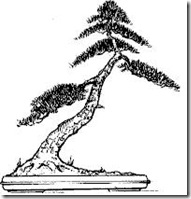Over the years many styles to classify Bonsai trees have been advanced, closely resembling circumstances in nature. These styles are open to personal interpretation and creativity, meaning that trees do not necessarily need to strictly conform to a style. Still, the styles are important to gain a basic understanding of Bonsai shapes and serve as guidelines to successfully train miniature trees.
The broom style is suited for deluous trees with extensive, five branching
The trunk is straight and upright and does not continue to the top of the tree, it branches out it all directions about 1/3 of the way up the entire height of the tree. In this manner, the branches and leaves form a ball-shapped crown which can also be very beautiful during the winter months
Chokkan
The formal upright style is a very common form of Bonsai. The style occurs often in nature, especially when the tree is exposed to lots of light and does not face the problem of competing trees
For this style, tapering of the upright-growing trunk must be clearly visible. The trunk must therefore be thicker at the bottom and must grow increasingly thinner with the height. At about 1/4 of the total  length of the trunk, branching should begin. The top of the tree should be formed by a single branch; the trunk should not span the entire height of the tree.
length of the trunk, branching should begin. The top of the tree should be formed by a single branch; the trunk should not span the entire height of the tree.
Moyogi
The informal upright style is common in both nature and in the art of Bonsai.
The trunk grows upright roughly in the shape of a letter ‘S’ and at every turn branching occurs. Tapering of the trunk must be clearly visible, with the base of the trunk thicker than the higher portions.
As a result of the wind blowing in one dominant direction or when a tree is in the shadow and must bend toward the sun, the tree will lean in one direction.
With Bonsai, the leaning style should grow at an angle of about 60 – 80 degrees relative to the ground. The roots are well developed on one side to keep the tree standing. On the side toward which the tree is leaning, the roots are clearly not as well developed. The first branch grows opposite the direction of the tree, in order to balance it. The trunk can be slightly bent or completely straight, but still be thicker at the bottom than at the top.
A tree living in the nature on a steep cliff can bend downward as a result of several factors, like snow or falling rocks.
These factors cause the tree to grow downward. With Bonsai it can be difficult to maintain a downward-growing tree because the direction of growth opposes the tree’s natural tendency to grow upright.
Cascade Bonsai are planted in tall pots. The tree should grow upright for a small distance but then bend downward. The crown of the tree usually grows above the rim of the pot, but the subsequent branches alternate left and right on the outermost curves of the S-shaped trunk. These branchings should grow out horizontally in order to maintain the balance of the tree.
Han-kengai
 The semi-cascade style, just like the cascade style, is found in nature on cliffs and on the banks of rivers and lakes.
The semi-cascade style, just like the cascade style, is found in nature on cliffs and on the banks of rivers and lakes.
The trunk grows upright for a small distance and then bends downward. Unlike the cascade style, the semi-cascade trunk will never grow below the bottom of the pot. The crown is usually above the rim of the pot while subsequent branching occurs below the rim.
In nature this style of tree grows in areas densely populated by many other trees and competition is so fierce that the tree can only survive by growing taller then all others around it.
The trunk grows crookedly upward and is completely without branching because the sun only hits the top of the tree. To make sure that it looks even tougher, some branches are “Jinned” (without bark). When the bark has been removed from one side of the trunk, the trunk is referred to as a “Shari”. The idea is to demonstrate that the tree really has to struggle to survive. These trees are often placed in small, round pots.
Fukinagashi
 The windswept style is also a good example of trees that must struggle to survive.
The windswept style is also a good example of trees that must struggle to survive.
The branches as well as the trunk grow to one side as though the wind has been blowing the tree constantly in one direction. The branches grow out on all sides of the trunk but will all eventually be bent to one side.
Sokan
The double trunk style is common in nature, but is not actually that common in the art of Bonsai.
Usually both trunks will grow out of one root system, but it is also possible that the smaller trunk grows out of the larger trunk just above the ground. The two trunks will vary in both thickness and length, the thicker and more developed trunk grows nearly upright, while the smaller trunk will grow out a bit slanted. Both trunks will contribute to a single crown of leaves.
Kabudachi
In theory the multi trunk style is the same as the double trunk style, but with 3 or more trunks.
All the trunks grow out of one root system, and it truly is one single tree. All the trunks form one crown of leaves, in which the thickest and most developed trunk forms the top.






Deprecated: strpos(): Passing null to parameter #1 ($haystack) of type string is deprecated in /home/agriviek8Qv/agriviet.net/public_html/wp-includes/comment-template.php on line 2522